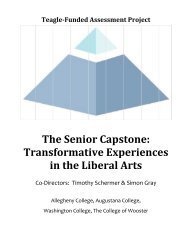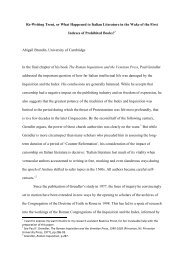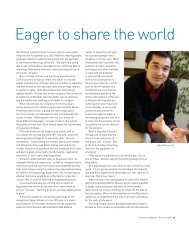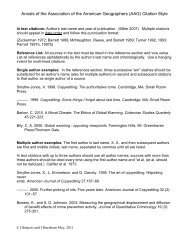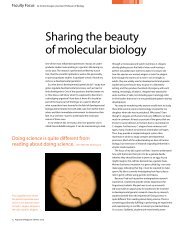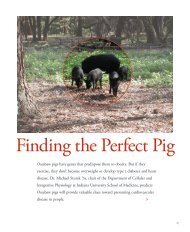Brad S. Gregory - Augustana College
Brad S. Gregory - Augustana College
Brad S. Gregory - Augustana College
You also want an ePaper? Increase the reach of your titles
YUMPU automatically turns print PDFs into web optimized ePapers that Google loves.
tumultuous years of the early German Reformation, when, it might be thought, such<br />
contestation might have been expected, but after which there was some movement toward<br />
agreement about the Bible‟s meaning, once things “settled down.” That is not what<br />
happened. It was not as if, say, once John Calvin rejected the Roman church in late 1533,<br />
or at any time between the first publication of his Institutes in 1536 and his death in 1564,<br />
Protestants tended toward a consensus around his exegetical claims and theological<br />
assertions. 41 On the contrary, like Luther, Calvin was involved in doctrinal controversies<br />
with other Protestants throughout his reforming career. 42 Commitment to the authority of<br />
scripture led neither obviously nor necessarily to justification by faith alone or to<br />
salvation through grace alone as the cornerstone doctrines of Christianity. The<br />
interpretations of many other anti-Roman Christians made abundantly clear that the Bible<br />
did not “interpret itself” in this way, whatever protagonists claimed to the contrary.<br />
Unfettered and unconstrained, the Reformation simply yielded the full,<br />
historically manifest range of truth claims made about what the Bible said. Seeing the<br />
historical consequences of the commitment to sola scriptura does not depend on<br />
examining all the myriad, biblically based truth claims made by those Christian groups<br />
and individuals who rejected the authority of the Roman church beginning in the early<br />
1520s and persisting through the mid-seventeenth century and beyond. The important<br />
analytical point is that every anti-Roman, Reformation-era Christian truth claim based on<br />
41 For Calvin‟s conversion, see the account in Bruce Gordon‟s recent biography, Calvin (New Haven and<br />
London: Yale University Press, 2009), pp. 33-35; see also the analysis of the events of autumn 1533 in the<br />
classic study by Alexandre Ganoczy, The Young Calvin, transl. David Foxgrover and Wade Provo<br />
(Philadelphia: Westminster Press, 1987), pp. 76-83.<br />
42 For a concise overview, see Richard C. Gamble, “Calvin‟s Controversies,” in The Cambridge<br />
Companion to John Calvin, ed. Donald K. McKim (Cambridge: Cambridge University Press, 2004), pp.<br />
188-203; see also Jean-François Gilmont, John Calvin and the Printed Book, transl. Karin Maag<br />
(Kirksville. Mo.: Truman State University Press, 2005), pp. 69-73, 93-107. On Luther‟s doctrinal conflicts<br />
with magisterial and radical Protestants, see Mark U. Edwards, Jr., Luther and the False Brethren<br />
(Stanford: Stanford University Press, 1975).<br />
17






